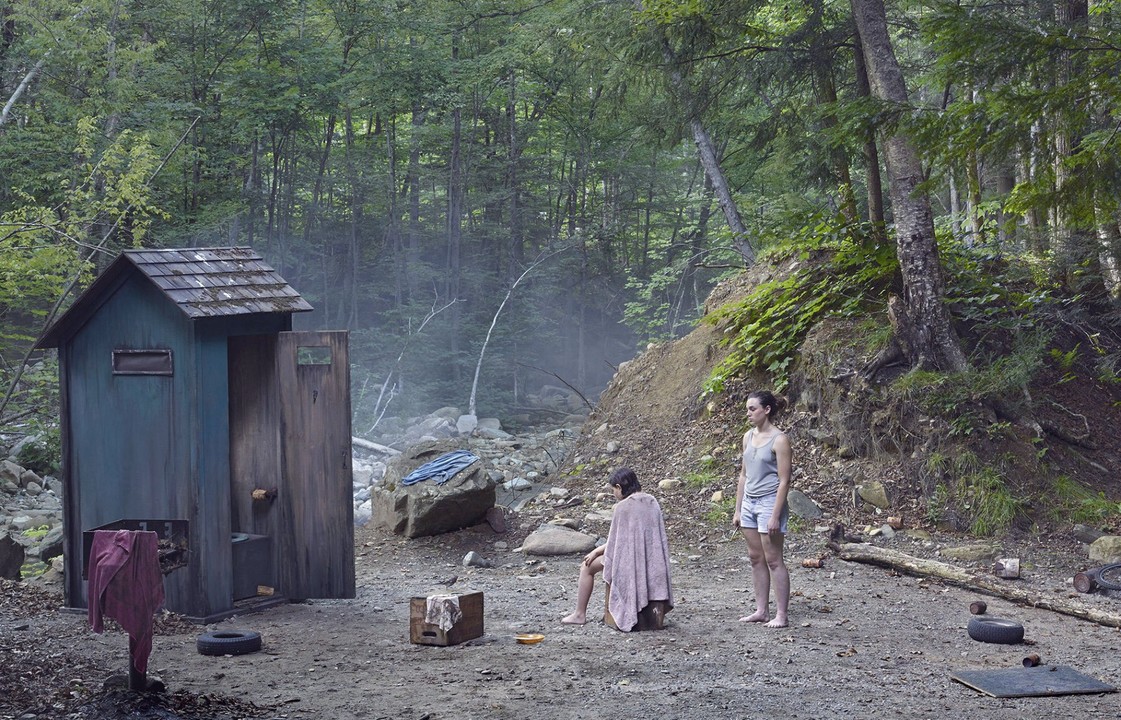
Review: 'Gregory Crewdson: Cathedral of the Pines' at The Photographers' Gallery, London
Exhibition dates: 23rd June - 8th October 2017
Gregory Crewdson The Haircut 2014 © Gregory Crewdson. Courtesy Gagosian
End of days
I have written critically and glowingly of Crewdson's work in the past (see my review of his exhibition at the Centre for Contemporary Photography, Melbourne 2012). With the exhibition Gregory Crewdson: Cathedral of the Pines the same elements are extant: life in the back woods of America, the tableaux beautifully staged and presented in large photographic prints throughout the three floors of the expansive spaces of the Photographers' Gallery, London. And yet there is something particularly "icky", if I can use that word, about this new body of work. What made me feel this way?
Firstly, I was uncomfortable with the number of naked or half-naked females (compared to men) in the photographs, all looking vulnerable, melancholic and isolated in small, rural town America. This is how Crewdson sees women in the microcosms he creates, women vulnerable in forest and cabin settings, but this incessant observation became/is objectionable to me. These are not powerful, strong, independent women, far from it. These are stateless women who peer endlessly out of windows, or sit on the end of beds looking downcast. It is almost degrading to females that these woman are so passive and objectified. Reinforcing the theme of isolation and desperation is the word "HELP!" painted on the bridge above a naked woman standing on a roadway; reinforcing the feeling of voyeurism is a woman's bra hanging in a toilet being observed by a man on a pair of skis.
Secondly, compared to the earlier series, the spaces in these new photographs seem to be completely dead. The photographs look handsome enough but they have a very different feel from the previous work. While externally referencing a sense of space and uncertainty present in B grade movies, European and American 19th century landscape paintings (where the human figure is dwarfed by the supposed sublime), and the paintings of Edward Hopper - the spaces in these new works feel closed, locked down and a bit scary. Nothing is real (and never has been) in Crewdson's work but this time everything seems to be over directed. As my friend Elizabeth Gertsakis observed, "The environmental context is chilling. The palette is extremely cold, there is no warmth at all. The viewer is not welcome, because there is nothing to be welcome to... even for curiosity's sake. No one is real here - everything is silent." Or dead. Or lifeless.
The whole series seems apathetic. That is, apathy with extreme effort. While Crewdson observes that the darkness lifted, leading to a reconnection with his artistic process and a period of renewal and intense creativity, this work is clearly at the end of something. As Elizabeth comments, "An invisible wall has come down here.... and there is absolutely no entry. This body of work is so much more pervy because it is so obvious and wooden. The camera here is well and truly in the mortuary and the photographer is the undertaker as well as the man who makes dead faces look 'human'." But he doesn't make them human, and there's the rub. Which all begs the question: where is this work going?
While Crewdson continues to move down a referential and associative path, the work fails to progress conceptually even as the work ultimately stagnates, both visually and emotionally. These wooden mise en scène are based on a very tired conceptual methodology, that of the narrative of the B grade movie which, if you have the money, time and willingness to invest in, can seem sufficiently sophisticated. Of course, buyers want to keep buying a signatory technique or idea that is easily recognisable and this adds to the cachet of the art... but as a critic you have to ask where the work is going, if an artist keeps repeating the same thing over and over and over again in slightly different contexts. Imagine if Degas had kept painting ballet dancers using the same lighting, the same perspective, the same colour palette, the same psychological investigation painting after painting... what we would be saying about the resulting work. Sure, there is great technical proficiency contained in Crewdson's work, but is he pushing the work anywhere more interesting? And the simple answer to that question is, no he isn't. No wonder he has been having a tough time reconnecting with his artistic process.
Dr Marcus Bunyan
SEE THE FULL POSTING AT http://wp.me/pn2J2-9w
Installation views of Gregory Crewdson: Cathedral of the Pines at The Photographers' Gallery, London





